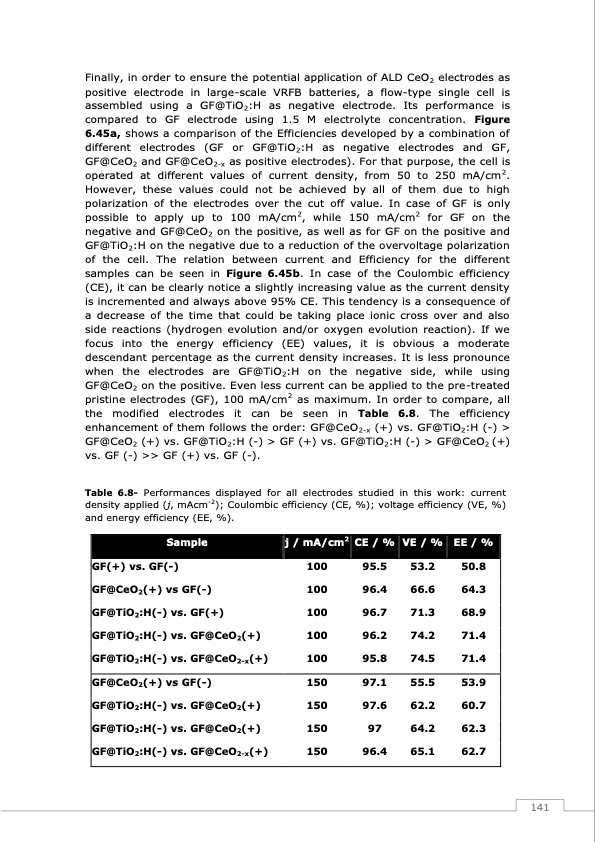
PDF Publication Title:
Text from PDF Page: 142
Finally, in order to ensure the potential application of ALD CeO2 electrodes as positive electrode in large-scale VRFB batteries, a flow-type single cell is assembled using a GF@TiO2:H as negative electrode. Its performance is compared to GF electrode using 1.5 M electrolyte concentration. Figure 6.45a, shows a comparison of the Efficiencies developed by a combination of different electrodes (GF or GF@TiO2:H as negative electrodes and GF, GF@CeO2 and GF@CeO2-x as positive electrodes). For that purpose, the cell is operated at different values of current density, from 50 to 250 mA/cm2. However, these values could not be achieved by all of them due to high polarization of the electrodes over the cut off value. In case of GF is only possible to apply up to 100 mA/cm2, while 150 mA/cm2 for GF on the negative and GF@CeO2 on the positive, as well as for GF on the positive and GF@TiO2:H on the negative due to a reduction of the overvoltage polarization of the cell. The relation between current and Efficiency for the different samples can be seen in Figure 6.45b. In case of the Coulombic efficiency (CE), it can be clearly notice a slightly increasing value as the current density is incremented and always above 95% CE. This tendency is a consequence of a decrease of the time that could be taking place ionic cross over and also side reactions (hydrogen evolution and/or oxygen evolution reaction). If we focus into the energy efficiency (EE) values, it is obvious a moderate descendant percentage as the current density increases. It is less pronounce when the electrodes are GF@TiO2:H on the negative side, while using GF@CeO2 on the positive. Even less current can be applied to the pre-treated pristine electrodes (GF), 100 mA/cm2 as maximum. In order to compare, all the modified electrodes it can be seen in Table 6.8. The efficiency enhancement of them follows the order: GF@CeO2-x (+) vs. GF@TiO2:H (-) > GF@CeO2 (+) vs. GF@TiO2:H (-) > GF (+) vs. GF@TiO2:H (-) > GF@CeO2 (+) vs. GF (-) >> GF (+) vs. GF (-). Table 6.8- Performances displayed for all electrodes studied in this work: current density applied (j, mAcm-2); Coulombic efficiency (CE, %); voltage efficiency (VE, %) and energy efficiency (EE, %). Sample j / mA/cm2 CE / % VE / % EE / % GF(+) vs. GF(-) GF@CeO2(+) vs GF(-) GF@TiO2:H(-) vs. GF(+) GF@TiO2:H(-) vs. GF@CeO2(+) GF@TiO2:H(-) vs. GF@CeO2-x(+) GF@CeO2(+) vs GF(-) GF@TiO2:H(-) vs. GF@CeO2(+) GF@TiO2:H(-) vs. GF@CeO2(+) GF@TiO2:H(-) vs. GF@CeO2-x(+) 100 95.5 53.2 50.8 100 96.4 66.6 64.3 100 96.7 71.3 68.9 100 96.2 74.2 71.4 100 95.8 74.5 71.4 150 97.1 55.5 53.9 150 97.6 62.2 60.7 150 97 64.2 62.3 150 96.4 65.1 62.7 141PDF Image | Redox Flow Batteries Vanadium to Earth Quinones

PDF Search Title:
Redox Flow Batteries Vanadium to Earth QuinonesOriginal File Name Searched:
FJVG_TESIS.pdfDIY PDF Search: Google It | Yahoo | Bing
Salgenx Redox Flow Battery Technology: Salt water flow battery technology with low cost and great energy density that can be used for power storage and thermal storage. Let us de-risk your production using our license. Our aqueous flow battery is less cost than Tesla Megapack and available faster. Redox flow battery. No membrane needed like with Vanadium, or Bromine. Salgenx flow battery
| CONTACT TEL: 608-238-6001 Email: greg@salgenx.com | RSS | AMP |